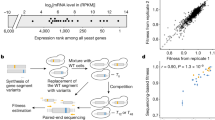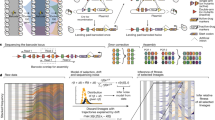Abstract
A major enigma in evolutionary biology is that new forms or functions often require the concerted effects of several independent genetic changes. It is unclear how such changes might accumulate when they are likely to be deleterious individually and be lost by selective pressure. The Saccharomyces cerevisiae prion [PSI+] is an epigenetic modifier of the fidelity of translation termination, but its impact on yeast biology has been unclear. Here we show that [PSI+] provides the means to uncover hidden genetic variation and produce new heritable phenotypes. Moreover, in each of the seven genetic backgrounds tested, the constellation of phenotypes produced was unique. We propose that the epigenetic and metastable nature of [PSI+] inheritance allows yeast cells to exploit pre-existing genetic variation to thrive in fluctuating environments. Further, the capacity of [PSI+] to convert previously neutral genetic variation to a non-neutral state may facilitate the evolution of new traits.
This is a preview of subscription content, access via your institution
Access options
Subscribe to this journal
Receive 51 print issues and online access
$199.00 per year
only $3.90 per issue
Buy this article
- Purchase on Springer Link
- Instant access to full article PDF
Prices may be subject to local taxes which are calculated during checkout





Similar content being viewed by others
References
Koch, A. L. Enzyme evolution. I. The importance of untranslatable intermediates. Genetics 72, 297–316 ( 1972).
Ohno, S. Evolution by Gene Duplication (Springer, New York, 1970).
Ohta, T. Simulating evolution by gene duplication. Genetics 115, 207–213 (1987).
Walsh, J. B. How often do duplicated genes evolve new functions? Genetics 139, 421–428 (1995).
Nadeau, J. H. & Sankoff, D. Comparable rates of gene loss and functional divergence after genome duplications early in vertebrate evolution. Genetics 147, 1259–1266 (1997).
Hall, B. G., Yokoyama, S. & Calhoun, D. H. Role of cryptic genes in microbial evolution. Mol. Biol. Evol. 1, 109–124 (1983).
Cox, B. [PSI], a cytoplasmic suppressor of super-suppression in yeast. Heredity 20, 505–521 ( 1965).
Liebman, S. W. & Sherman, F. Extrachromosomal psi+ determinant suppresses nonsense mutations in yeast. J. Bact. 139 , 1068–1071 (1979).
Firoozan, M., Grant, C. M., Duarte, J. A. & Tuite, M. F. Quantitation of readthrough of termination codons in yeast using a novel gene fusion assay. Yeast 7, 173– 183 (1991).
Serio, T. R. & Lindquist, S. L. [PSI+]: an epigenetic modulator of translation termination efficiency. Annu. Rev. Cell Dev. Biol. 15, 661–703 ( 1999).
Stansfield, I. et al. The products of the SUP45 (eRF1) and SUP35 genes interact to mediate translation termination in Saccharomyces cerevisiae. EMBO J. 14, 4365–4373 (1995).
Zhouravleva, G. et al. Termination of translation in eukaryotes is governed by two interacting polypeptide chain release factors, eRF1 and eRF3. EMBO J. 14, 4065–4072 ( 1995).
Patino, M. M., Liu, J. J., Glover, J. R. & Lindquist, S. Support for the prion hypothesis for inheritance of a phenotypic trait in yeast. Science 273, 622– 626 (1996).
Paushkin, S. V., Kushnirov, V. V., Smirnov, V. N. & Ter-Avanesyan, M. D. Propagation of the yeast prion-like [psi+] determinant is mediated by oligomerization of the SUP35-encoded polypeptide chain release factor. EMBO J. 15, 3127–3134 ( 1996).
Kikuchi, Y. & Kikuchi, A. in Gene Expression and Regulation: the Legacy of Luigi Gorini (eds Bissell, M., Deho, G., Sironi, G. & Torriani, A.) 257–264 (Elsevier, Amsterdam, 1988).
Kushnirov, V. V. et al. Nucleotide sequence of the SUP2 (SUP35) gene of Saccharomyces cerevisiae. Gene 66, 45– 54 (1988).
Wilson, P. G. & Culbertson, M. R. SUF12 suppressor protein of yeast. A fusion protein related to the EF-1 family of elongation factors. J. Mol. Biol. 199, 559– 573 (1988).
Ter-Avanesyan, M. D., Dagkesamanskaya, A. R., Kushnirov, V. V. & Smirnov, V. N. The SUP35 omnipotent suppressor gene is involved in the maintenance of the non-Mendelian determinant [psi+] in the yeast Saccharomyces cerevisiae . Genetics 137, 671– 676 (1994).
Liu, J. J. & Lindquist, S. Oligopeptide-repeat expansions modulate ‘protein-only’ inheritance in yeast. Nature 400, 573–576 ( 1999).
Kushnirov, V. V. et al. Divergence and conservation of SUP2 (SUP35) gene of yeast Pichia pinus and Saccharomyces cerevisiae. Yeast 6, 461–472 ( 1990).
Chernoff, Y. et al. Evolutionary conservation of prion-forming abilities of the yeast Sup35 protein. Mol. Microbiol. 35, 865–876 (2000).
Santoso, A., Chien, P., Osherovich, L. Z. & Weissman, J. S. Molecular basis of a yeast prion species barrier. Cell 100, 277–288 (2000).
Kushnirov, V. V., Kochneva-Pervukhova, N. V., Chechenova, M. B., Frolova, N. S. & Ter-Avanesyan, M. D. Prion properties of the Sup35 protein of yeast Pichia methanolica. EMBO J. 19, 324–331 ( 2000).
Tuite, M. F., Mundy, C. R. & Cox, B. S. Agents that cause a high frequency of genetic change from [psi+] to [psi-] in Saccharomyces cerevisiae. Genetics 98, 691–711 ( 1981).
Adams, A., Gottschling, D. E., Kaiser, C. A., Stearns, T. Methods in Yeast Genetics (Cold Spring Harbor Laboratory Press, Plainview, 1997).
Hampsey, M. A review of phenotypes in Saccharomyces cerevisiae. Yeast 13, 1099–1133 ( 1997).
Rieger, K. J. et al. Large-scale phenotypic analysis—the pilot project on yeast chromosome III. Yeast 13, 1547– 1562 (1997).
Budavari, S. (ed.) The Merck Index (Merck and Company, Rahway, New Jersey, 1989).
Roncero, C., Valdivieso, M. H., Ribas, J. C. & Duran, A. Isolation and characterization of Saccharomyces cerevisiae mutants resistant to Calcofluor white. J. Bacteriol. 170, 1950–1954 (1988).
Lund, P. M. & Cox, B. S. Reversion analysis of [psi-] mutations in Saccharomyces cerevisiae. Genet. Res. 37, 173–182 (1981).
Derkatch, I. L., Bradley, M. E., Zhou, P., Chernoff, Y. O. & Liebman, S. W. Genetic and environmental factors affecting the de novo appearance of the [PSI+] prion in Saccharomyces cerevisiae. Genetics 147, 507–519 ( 1997).
Eaglestone, S. S., Cox, B. S. & Tuite, M. F. Translation termination efficiency can be regulated in Saccharomyces cerevisiae by environmental stress through a prion-mediated mechanism. EMBO J. 18, 1974– 1981 (1999).
Grant, C. M., Firoozan, M. & Tuite, M. F. Mistranslation induces the heat-shock response in the yeast Saccharomyces cerevisiae. Mol. Microbiol. 3, 215–220 (1989).
Parsell, D. A. & Lindquist, S. The function of heat-shock proteins in stress tolerance: degradation and reactivation of damaged proteins. Annu. Rev. Genet. 27, 437–496 (1993).
Bailleul, P. A., Newnam, G. P., Steenbergen, J. N. & Chernoff, Y. O. Genetic study of interactions between the cytoskeletal assembly protein sla1 and prion-forming domain of the release factor sup35 (eRF3) in Saccharomyces cerevisiae. Genetics 153, 81– 94 (1999).
Tikhomirova, V. L. & Inge-Vechtomov, S. G. Sensitivity of sup35 and sup45 suppressor mutants in Saccharomyces cerevisiae to the anti-microtubule drug benomyl. Curr. Genet. 30, 44–49 (1996).
Liebman, S. W. & Derkatch, I. L. The yeast [PSI+] prion: making sense of nonsense. J. Biol. Chem. 274, 1181–1184 (1999).
Seoighe, C. & Wolfe, K. H. Updated map of duplicated regions in the yeast genome. Gene 238, 253– 261 (1999).
Olson, M. V. When less is more: gene loss as an engine of evolutionary change. Am. J. Hum. Genet. 64, 18–23 (1999).
Levitt, R. C. Polymorphisms in the transcribed 3′ untranslated region of eukaryotic genes. Genomics 11, 484– 489 (1991).
Czaplinski, K. et al. The surveillance complex interacts with the translation release factors to enhance termination and degrade aberrant mRNAs. Genes Dev. 12, 1665–1677 ( 1998).
Mewes, H. W. et al. Overview of the yeast genome. Nature 387, 7–65 (1997).
Rutherford, S. L. & Lindquist, S. Hsp90 as a capacitor for morphological evolution. Nature 396, 336–342 (1998).
Chernoff, Y. O., Lindquist, S. L., Ono, B., Inge-Vechtomov, S. G. & Liebman, S. W. Role of the chaperone protein Hsp104 in propagation of the yeast prion-like factor [psi+]. Science 268, 880–884 (1995).
Chernoff, Y. O. et al. Conservative system for dosage-dependent modulation of translational fidelity in eukaryotes. Biochimie 74, 455 –461 (1992).
Zhou, P. et al. The yeast non-Mendelian factor [ETA+] is a variant of [PSI+], a prion- like form of release factor eRF3. EMBO J. 18, 1182–1191 (1999).
Eustice, D. C., Wakem, L. P., Wilhelm, J. M. & Sherman, F. Altered 40S ribosomal subunits in omnipotent suppressors of yeast. J. Mol. Biol. 188, 207–214 (1986).
Wakem, L. P. & Sherman, F. Isolation and characterization of omnipotent suppressors in the yeast Saccharomyces cerevisiae. Genetics 124, 515–522 ( 1990).
Ter-Avanesyan, M. D. et al. Deletion analysis of the SUP35 gene of the yeast Saccharomyces cerevisiae reveals two non-overlapping functional regions in the encoded protein. Mol. Microbiol. 7, 683– 692 (1993).
Acknowledgements
We thank members of the Lindquist lab and M. Jensen for discussion and comments on the manuscript, and V. Iyer, P.O. Brown, J. Henikoff and S. Henikoff for collaborative efforts and for allowing us to cite unpublished work. This research was supported by the Jane Coffin Childs Memorial Fund for Medical Research (H.L.T.), the National Institutes of Health and the Howard Hughes Medical Institute.
Author information
Authors and Affiliations
Supplementary information
Rights and permissions
About this article
Cite this article
True, H., Lindquist, S. A yeast prion provides a mechanism for genetic variation and phenotypic diversity. Nature 407, 477–483 (2000). https://doi.org/10.1038/35035005
Received:
Accepted:
Issue Date:
DOI: https://doi.org/10.1038/35035005
This article is cited by
-
The phenomenon of strain degeneration in biotechnologically relevant fungi
Applied Microbiology and Biotechnology (2023)
-
Differential effects of steroid hormones on levels of broad-sense heritability in a wild bird: possible mechanism of environment × genetic variance interaction?
Heredity (2022)
-
The Boggarts of biology: how non-genetic changes influence the genotype
Current Genetics (2021)
-
Protein assembly systems in natural and synthetic biology
BMC Biology (2020)
-
The causes of evolvability and their evolution
Nature Reviews Genetics (2019)
Comments
By submitting a comment you agree to abide by our Terms and Community Guidelines. If you find something abusive or that does not comply with our terms or guidelines please flag it as inappropriate.



